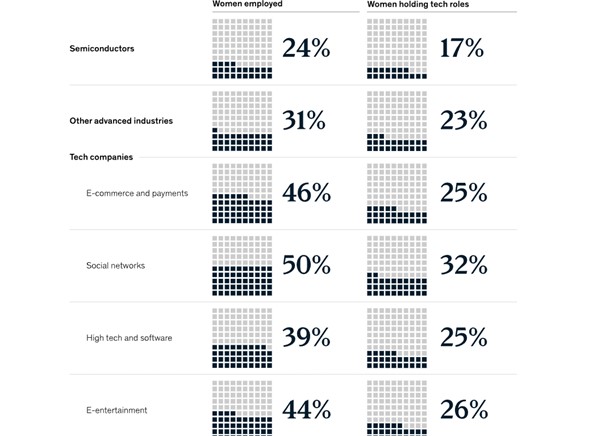
What is Recruitment and Selection Process in HRM? Benefits & Best Practices
24/04/2024
What Are Different Types of Compliance?
30/04/2024The semiconductor sector is in a pivotal competition, knowing that chips will drive the forefront of future growth and innovation. Countries like South Korea, Germany, United States have revealed plans of massive new semiconductor facilities that are to be started. Overall, the source says that there would be investments close to $1 trillion between 2023 to 2030. Source: McKinsey analysis of data from Gartner and Semiconductor Industry Association (SIA),2023
India has been seeing massive investments flowing in from countries looking to set up semiconductor units in our country leading to the creation of thousands of job opportunities. The government recently approved investments worth $15 billion in the sector including the Tata group. According to Randstad, the sector is set to see over 1 million job openings in the next few years indicating an all-time high in demand for talent.
However, plans of setting up manufacturing units, is just one part of the boom of the semiconductor sector, the actual problem lies in finding the talent to facilitate this boom.
In the United States, official estimates suggest that companies across industries will face a shortfall of 300,000 engineers and 90,000 skilled technicians by 2030. Source: Integrated Post Secondary data education system; US bureau of labour statistics
In order to operate in full steam, companies must make sure they attract qualified, skilled talent before the massive projects start operations.
Prioritizing talent is no more just another strategic move in the semiconductor industry, it’s a necessary step.
Where the Problem Lies
Even before talking about the investments and thinking about the future talent scenario we need to look into the shortage of qualified talent we are already facing. But not all the regions face the same kind of talent challenges. Here are a few examples showing how different regions face different talent challenges.
- India is one of the largest producer and exporter of engineering graduates
- Japan and Korea face major shortage in engineering talent
What we could derive from the particular situation was that new graduates are unaware of the openings or opportunities in the industry causing them to miss out on it, automatically leading to increasing demand in specific talent in the regions where the production of graduates was way lesser.
Talking about the big guns of the industry, here are some problems they face-
- Major manufacturing and designing companies, with heavy capital invested equipment designed to produce chips are also facing a shortage of skilled talent with required added technical capabilities.
- Companies supplying equipment for these heavy machines are also struggling to fill the talent gap.
The obvious analysis was the increased demand for tech talent in the semiconductor industry.
Key Actions to Win the War for Talent
The battle for tech talent in the semiconductor is big. However, there are certain action semiconductor industries can take to tackle the problem and win talent.
1. Identify the reasons for the current attrition
The way of work changed drastically for employees in the past few years. Meeting the new expectations of employees with respect to their career concerns must be top priority for semiconductor companies in order to attract skilled talent. Here are a few things you could focus on
2. Help craft a non-traditional but desirable career path for advancement
Most companies go by the traditional approach regarding employees’ career paths, like promoting consistent, excellent work by rewarding them with a promotion of becoming a manager. While this is rewarding, not all high performing professionals prefer to or have people skills to manage people when they are given a chance to move to the two tops.
Instead, companies can
- Focus on defining career paths that are relevant to the individual skills to contribute to the organization
- Seek clear expectations of managers to lead teams
- Provide the “people skills” people with training, skills, and tools to excel in it
3. Do not be rigid with workplace flexibility
Technology is your best friend! Create a strategic approach to monitor on-site and remote work and encourage hybrid working models. Workplace technologies can enable communication seamlessly from anywhere, make use of it.
4. Untapped talent pools are the ones to look for
Talent is often overlooked. Semiconductor companies must make sure they find these.
A study revealed women account for
- 17 percent of tech roles in the semiconductor industry
- 32 percent in social media
- 23 percent in industrials
Source: McKinsey
It was found that Women leaders were more likely to leave inflexible jobs or go for companies that valued diversity, equality, and inclusion.
In terms of women employment, the semiconductor industry lags, advanced industries and tech companies in Europe.
% of employees. n => 1 million profiles

Source: Analysis of 2022 data from Eightfold AI by McKinsey and Eightfold AI
Some tips to tap into the overlooked talent pool
- Focus on providing flexible work options along with other benefits like healthcare
- Older adults with special competencies in the semiconductor R&D sector, with lack of opportunities due to societal barriers and other reasons are a great pool of talent to tap into
- Focus on individual skills rather than credentials for role requirements. For example, process engineers in fabs must be adept at areas such as quality assurance and statistical control, continuous improvement of processes, and the ability to develop new processes, support new product introduction, and lead process-related customer meetings. Sometimes, a shift leader may have all these skills but without a degree. Do not discard them.
- Use Generative AI to scour through unstructured data and gather individuals with skills they have used in previous roles. Look into individuals that have skills that are transferable to roles.
5. Polish your storytelling skills related to the semiconductor industry
You must narrate a story, highlight points to inspire and spark interest among professionals as to why the semiconductor industry would be perfect for their career advancement.
- Highlight the fast pace technological innovation involved in the industry
- Provide upskilling and training to individuals, demonstrating your interest in their career paths
- Collaborate with universities and research centres to increase student exposure towards the grand semiconductor industry opportunities.
- Communicate to individuals with highly specialized roles in the industry as to how their work is contributing to the success of the organization.
Research found that when employees find their work to be meaningful, their performance improves by 33 percent, they are 75 percent more committed to their organization, and they are 49 percent less likely to leave.
Source: People and Organization blog by Mckinsey
6. Invest in internal skill building of employees
Most times, talent is right under your nose, but you are missing it, because you aren’t focussing on the right parameters.
- Provide training to individuals within the organization. Upskill or reskill them, more like taking them on as apprentices, giving them on-the job training.
- Decrease onboarding times by using technological levers, increasing knowledge management.
- Use generative AI to expedite repetitive work, accelerate skills development and reduce skills requirement.
7. Outsource labour to manage shortages
No matter how successful your recruitment journey may be, there will always be labour shortages, especially for roles that are not needed on a long-term basis. What can you do to overcome this?
- Outsource your needs to third party labour services to fill in critical gaps
- Work closely with the third-party service provider to ensure quality outcomes
- Properly allocate resources, maintain schedules as planned
With proper planning and management, outsourced labour services can be extremely convenient and fruitful.
Recruit, Upskill, reskill! Do whatever it takes to close the talent gap!
It’s not just the semiconductor industry that’s facing the talent shortage, there are others as well. Organizations, in the coming years, must play smart and expand their talent pools with a more strategic and resourceful approach, as well put an effort to upskill the existing workforce.
The rapid growth of the semiconductor industry will see an increase in demand for talent which must be met by faster, more hiring in shorter time frames. In fact, the industry and the government has also recognized the need for closing skill gaps in order to support and accelerate the work requirements in the semiconductor industry. A number of programmes have been introduced to help fill this skill gap by providing skilled workers, along with further evaluation of the programs to understand their extent of effectiveness and modification of the same.
Contact Us For Business Enquiry

Rajkumar Shanmugam
Rajkumar Shanmugam is the Head of HR at ALP Consulting, bringing over 19 years of comprehensive HR leadership experience across India and international markets. His expertise spans talent acquisition, employee relations, performance management, compliance, and HR transformation. Rajkumar has a proven track record of driving people-centric initiatives, enhancing workplace culture, and aligning HR strategy with business goals. With extensive experience in US staffing operations and global mobility, he continues to lead organizational excellence through innovation and employee engagement.




